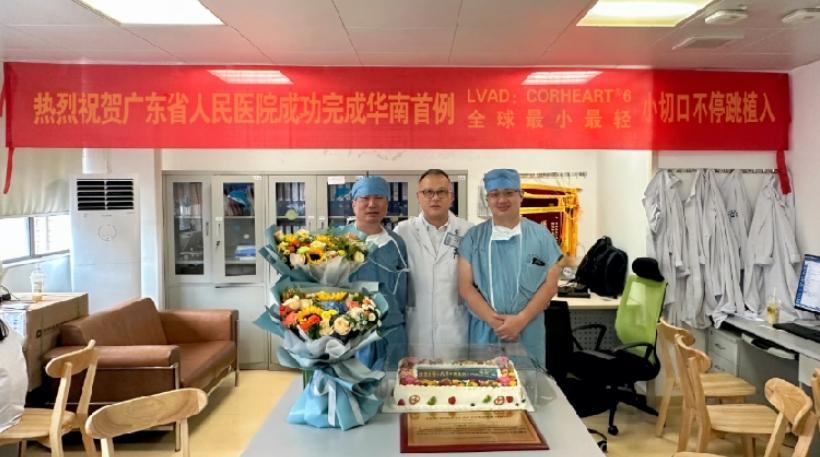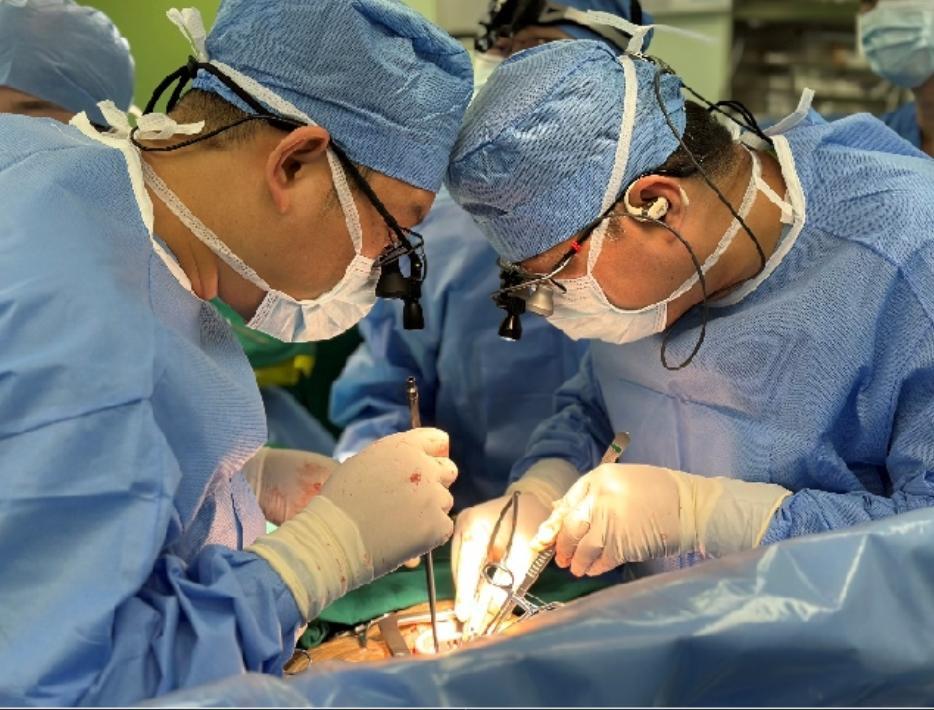
On October 6th, Ms. Pan from Qingyuan went to the local hospital for a follow-up examination. Her various physical indicators indicated that she had recovered well, which relieved the Guangzhou doctors who had been concerned about her. Just over a month ago, she had surgery to implant the world's smallest and lightest magnetically levitated continuous-flow left ventricular assist device at the Guangdong Provincial People's Hospital, which was also the first case of artificial beating-heart minimally invasive implantation in South China without median sternotomy.

Implanting a miniature artificial heart is the best choice
Ms. Pan, 59 years old, was diagnosed with dilated cardiomyopathy over ten years ago. She had a pacemaker implanted due to recurrent chest tightness and shortness of breath and has been on medication treatment ever since. In August this year, she was admitted to the Cardiovascular Surgery Department of Guangdong Provincial People's Hospital for emergency hospitalization due to an exacerbation of Congestive Heart Failure (CHF) caused by a sudden infection.
The echocardiogram showed that after the pacemaker implantation, her atrium sinistrum and atrium dextrum both enlarged, far exceeding the normal heart size. There was also severe mitral regurgitation and severe tricuspid regurgitation, suffering Class iv heart failure according to the New York Heart Association (NYHA) Classification of Heart Failure. The situation was extremely critical.
The team of Professor Huang Jinsong and Professor Wu Min from the Heart Transplantation and Ventricular Assist Device Surgery Department of the Guangdong Provincial People's Hospital conducted a comprehensive evaluation of Ms. Pan's condition and ultimately decided to implant her with the world's smallest and lightest magnetically levitated continuous-flow left ventricular assist device - Corheart®6.
Professor Huang Jinsong introduced that traditional artificial heart implantation surgery often requires median sternotomy, while Ms. Pan's condition is more complicated; in addition, the artificial heart used in this surgery weighs only 90g, creating conditions for minimally invasive surgery.
Professor Wu Min, the chief surgeon, explained that an artificial heart is commonly referred to as a "ventricular assist device." It does not replace the heart but is installed on the heart to "share" the workload of ventricular ejection. It uses mechanical means to transport blood to various organs throughout the body.
Practice with six sheep before the surgery in advance
On August 23rd, Ms. Pan entered the operating room. One of the difficulties of this surgery is to puncture, trim, and install an artificial heart on the beating heart.
Professor Wu Min explained that beating-heart heart surgery is more conducive to protecting the patient's residual heart function. "The key operation only needs a few minutes, but it is very dangerous. If the doctor is not careful, the blood may burst out at once, so our team conducts exercises on six sheep before the operation to ensure cooperation."
With the joint efforts of the multidisciplinary team at Guangdong Provincial People's Hospital, Ms. Pan's atrium sinistrum has significantly reduced in volume, and the symptoms of mitral and tricuspid regurgitation have improved. She was transferred from the ICU to a general ward on the fifth day. After 12 days, all of Ms. Pan's indicators met the requirements for discharge.
China's self-developed artificial hearts have advantages in both performance and price
According to statistics, there are currently about 15 million heart failure patients in China, including one million end-stage heart failure patients like Ms. Pan. Heart transplantation is the only effective treatment to save the lives of these patients. However, there are only 700-800 cases of heart transplantation donors each year, which is far from meeting the needs of the patients. The emergence of artificial hearts brings hope to the patients.
It is understood that the artificial heart implanted in Ms. Pan's body this time is an artificial heart, the "third-generation magnetically levitated continuous-flow left ventricular assist device" independently developed by Shenzhen Core Medical Technology Co., Ltd. It is the most advanced artificial heart in the world. Its implementation marks the beginning of a new era in the treatment of heart failure in China. "Currently, there are four of China's self-developed artificial heart brands used in clinical practice, which have more advantages compared to foreign brands in terms of performance and price", commented Professor Wu Min.
华南首例!全球最小人工心脏小切口不停跳植入
10月6日,清远市民潘女士到当地医院复查,她身体各项指标恢复良好,让一直牵挂她的广州医生们都松了口气。就在一个多月前,她在广东省人民医院植入了目前全球最小最轻的全磁悬浮人工心脏,也是华南地区首例以不正中开胸、小切口的方式植入人工心脏的手术。
植入超小人工心脏是最佳选择
59岁潘女士10多年前就被确诊为扩张型心肌病,因反复胸闷气短植入了起搏器,之后一直维持药物治疗。今年8月,她因突发感染引发心衰急性加重,紧急到广东省人民医院心外科进行住院治疗。
心脏超声检查显示,在植入起搏器后,她的左心及右房都呈扩大状,远超常人心脏大小,还伴随重度二尖瓣反流及重度三尖瓣反流,心功能只有Ⅳ级(NYHA分级),情况十分危急。
该院心脏移植与辅助外科黄劲松、吴敏教授团队综合评估了潘女士的病情,最终决定为其植入一颗全球最小最轻的人工心脏——Corheart® 6。
黄劲松教授介绍,传统的人工心脏植入手术常常需要开胸,而潘女士的病情较复杂;加上本次手术采用的人工心脏仅有90g重,为小切口手术创造了条件。
主刀医生吴敏教授解释,人工心脏是“心室辅助装置”通俗的说法,它不是取代心脏,而是安装在心脏上,“分担”心室射血的部分工作,利用机械的方法把血液输送到全身各器官。
提前用6只羊演练
8月23日,潘女士被推进了手术室。这台手术的难点之一就是在心脏不停跳的情况下在心脏上完成打洞、修剪、安装人工心脏等操作。
吴敏教授解释,心脏不停跳进行手术更有利于保护患者残留心脏功能,“关键的操作只有几分钟,但十分惊心动魄,一不小心,血就可能一下子飙出来,所以在手术前我们团队在6只羊的身上进行演练,确保配合亲密无间、手术精细无瑕。”
在广东省人民医院多学科团队的共同努力下,潘女士的左心室体积明显缩小,二、三尖瓣反流症状好转,第五天便从ICU转到普通病房。12天后,潘女士的各项指标就达到了出院要求。

国内自主研发人工心脏性能和价格都有优势
据统计,目前我国约有1500万名心衰患者,其中有100万名像潘女士这样的终末期心衰患者,心脏移植是挽救这些患者生命的唯一有效治疗手段,但心脏移植供体每年仅有700—800例,远不能满足患者数量上的需要,人工心脏的出现则为患者带来了生命的希望。
据了解,本次植入潘女士体内的人工心脏是深圳核心医疗自主研发的一颗国产人工心脏,属于“第三代全磁悬浮人工心脏”,属于世界上最先进的人工心脏。第三代全磁悬浮人工心脏植入术的实施标志着我国已开启心衰治疗的新时代。“目前临床使用的我国自主研发人工心脏已有4个品牌,从性能到价格,与国外品牌相比都更有优势。”吴敏教授评价。
文丨记者 陈辉 林清清
图丨受访者提供
翻译丨白心怡
责编丨古司祺
校对丨马曼婷
-
DATA TALK丨The Belt and Road Initiative: To create new paradigm for international cooperation
2023-10-11 14:46:38 -
2023 Intelligent Technology Exhibition in Vietnam round off
2023-10-10 22:36:40 -
Video丨Acrobatic drama "Swan" to be staged in Guangzhou this weekend
2023-10-10 22:36:35 -
Company based in Guangzhou contributes to the dazzling stage lights of the Hangzhou Asian Games
2023-10-10 22:36:30






